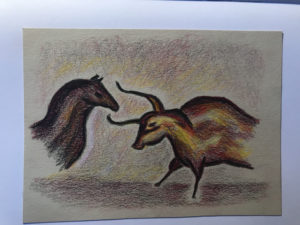Learn the basics of Neurographic Art so you can benefit from this easy meditative art movement.

Sketch Journal Page – “Florist Shelf”
Florist Shelf
This week I’ve created a florist shelf with watercolor and markers for my sketch journal. You can follow along with this video.
[embedyt] https://www.youtube.com/watch?v=sEGxJDDDj00[/embedyt]
My Process
Pencil sketch.
Ink over.
Watercolor wash.
Markers.
Gratitude notes.
Sketch journaling is a way to document what happens in your life, once or twice a month.
A sketch journal is a beautiful memory book for how life was for you in any given each year.
What do you think?

Aspiring Artist Activity: Florist Shelf
In your sketchbook please do the following:
- Draw three shelves.
- Add assorted florist details just like we did.
Share your sketch journal pages with us on the hashtag #AlisonHazelArt so we can find your images.
We’d love to see what you create.

Author Bio: Alison Hazel
Alison Hazel is a hobby artist and she shares her ongoing journey about becoming an artist later in life. She creates simple art that anyone can make. She hopes to inspire you to reach your creative potential in the area that suits you.

Light and Color for Aspiring Artists
Introduction As an aspiring artist, I've always been fascinated with color, how we see it, where it comes from and how it can change your mood. Many of the great artists chose their color palettes and stuck to them through the different emotional stages of life. In...

Artzlife Newsletter
Author: Alison Hazel - Published: December 2024 Artzlife Newsletter Creative art journal inspiration for hobby artists Welcome to a Place for Passionate Hobby Artists Are you a hobby artist seeking inspiration, connection and gentle guidance on your creative...










